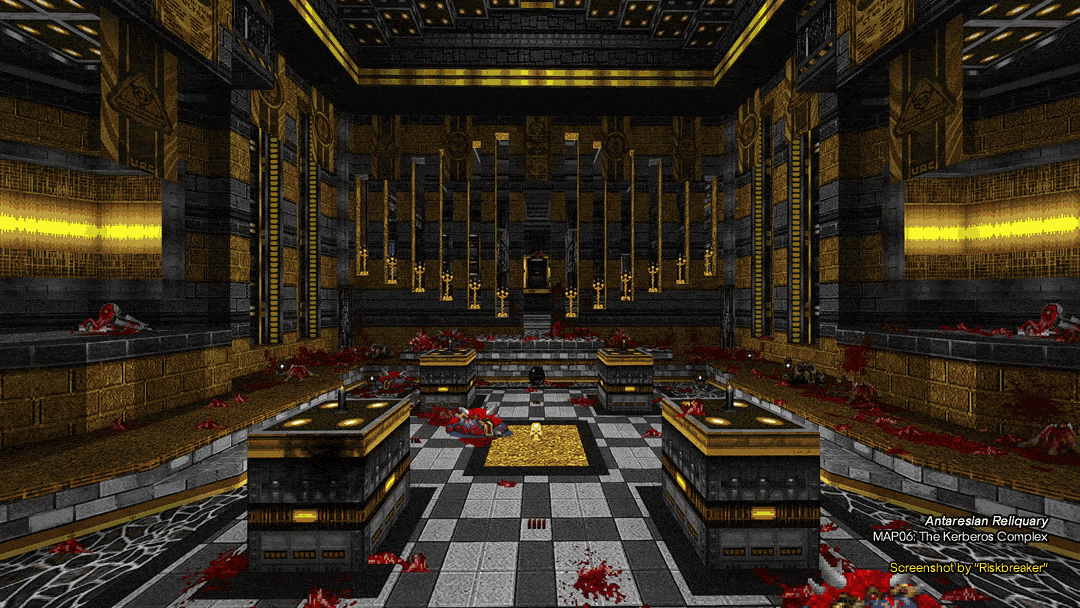
If you're new to the concept, WADs (acronym for "Where's All the Data") are fan-made modifications for Doom 2. They're free downloadable packs that you can run in a Doom "source port" like GZDoom. They traditionally feature new maps, maybe some new weapons/monsters, and in the case of the more ambitious WADs, all the above.
To give you some idea of the dedication and talent that goes into some of these WADs, let me tell you about what happens in the final chapter of "Eviternity", a colossal 32-level megawad. Escaping from the depths of hell, the player arrives at the gates of heaven, facing a city of white marble, gold walls, pink skies and floating gardens. Heading towards a floating demonic citadel attached by massive chains, you fight your way across the holy streets, and marching across a sea of fresh demon corpses, you remove the chains from the citadel, sending it plummeting into the clouds. The final chapter concludes with the 43 minute prog rock epic "The Godhood Suite", composed by MIDI legend James Paddock. Yes, that's right. 43 minutes.
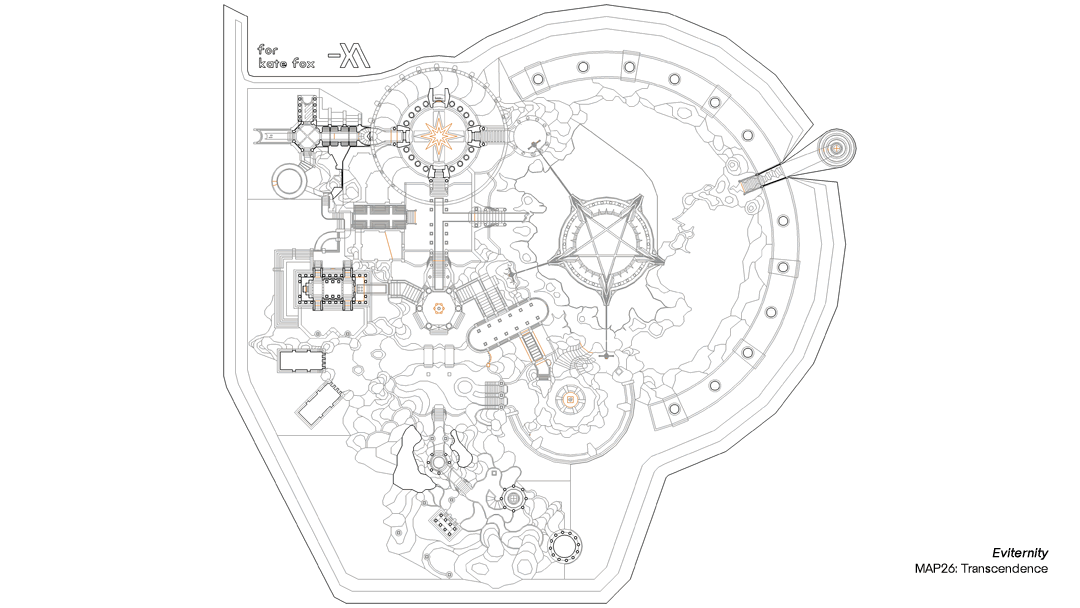
So what makes classic Doom special, worthy of so much passion and dedication? First, you can't ignore the timeless moment-to-moment joy of Doom's gameplay formula. Throw out your preconceptions: what people love about Doom is not merely nostalgia. To this day, it's a gameplay loop that is immersive, accessible, exciting, and always challenging. It only takes an afternoon to learn, but a lifetime to master. It's a sandbox of interesting systems and interesting ways to interact with them. It rewards exploration and creativity, constantly asks you to take risks and rewards you for a job well done. It treats you harshly but fairly, and every meter of progress feels like a personal achievement. It's a game that makes you learn its dance, but is fun even when you don't know the moves. In modern times, the soul of the FPS genre has revolved in new directions, but I'm not sure it's evolved — Doom's virtues are eternal.
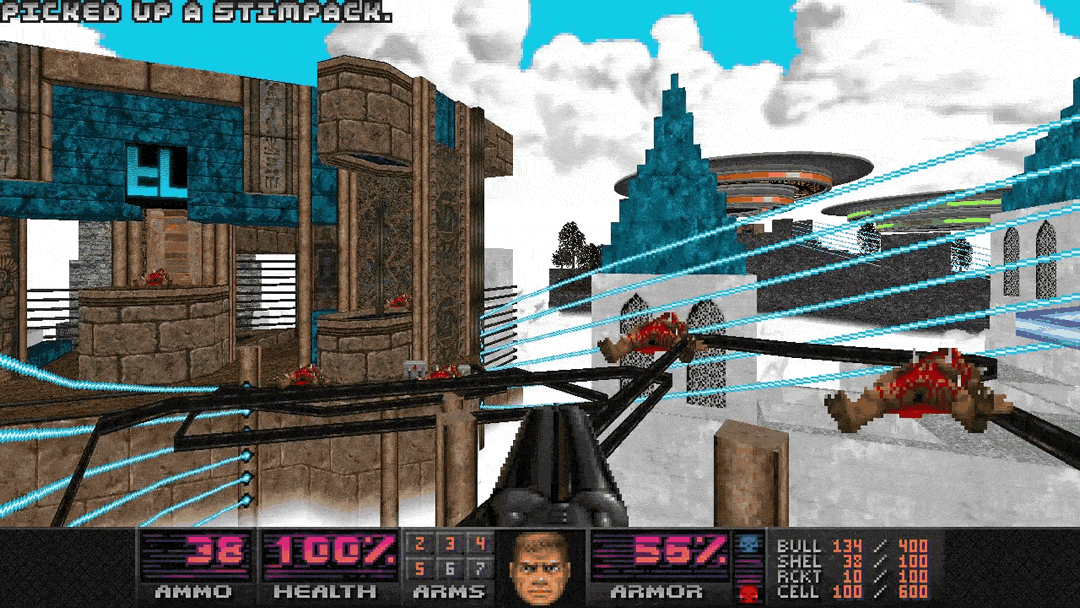
That being said, you can only play the original games so many times until they get dull. And sure, even if its core systems were ageless, not every aspect of the experience has held up super well. For instance, the level design is simplistic by today's standards, the music is fun but repetitious, and the engine itself desperately needed some technical modernization.
This is where my own introduction to the underappreciated, blood-splattered world of Doom WADs began. A WAD that made a lasting impression on me was "Void", which came out in 2003. It followed the release of ZDoom, a source port of Doom 2 that rewrote its original engine code to allow it to run on modern operating systems, along with adding new capabilities to the then-dated Doom engine. Being developed specifically for ZDoom, Void was designed to show off ZDoom's new technical features and expand on Doom's gameplay.
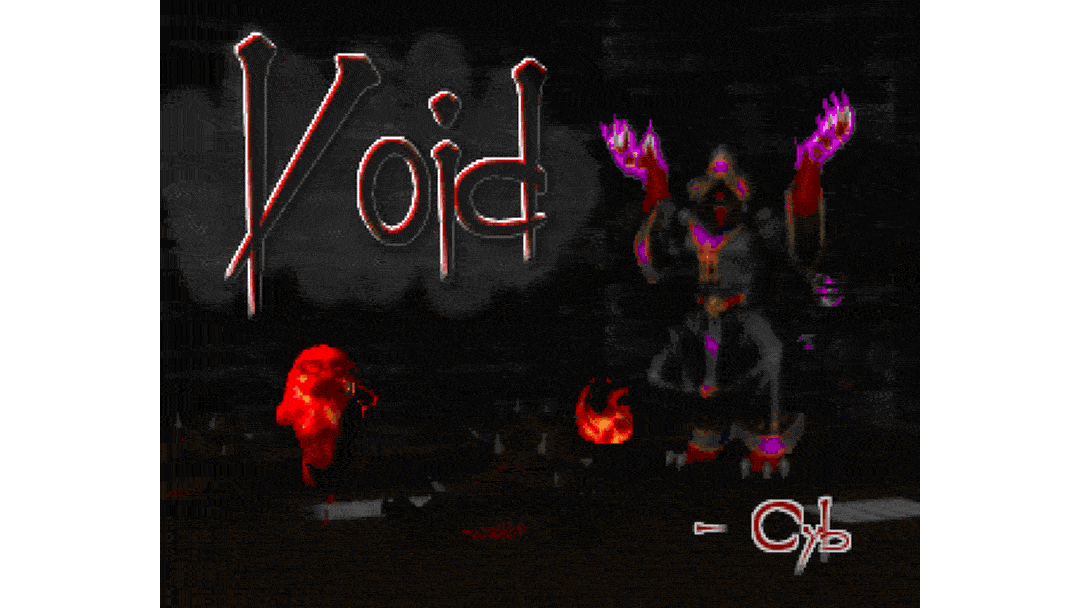 Void, following WAD tradition, is paper-thin on story but heavy on gameplay and atmosphere. The story begins with a group of scientists accidentally summoning the Heresiarch from Hexen, who pulls the science team (who are inexplicably also space marines) into a twisted gothic world inspired by American McGee's Alice. Courtesy of the new features unlocked by ZDoom, Void featured technically unprecedented environments, off-beat gameplay that combined puzzle solving, platforming, and the usual demon-slaying action. It's a tightly designed WAD that still holds up today.
Void, following WAD tradition, is paper-thin on story but heavy on gameplay and atmosphere. The story begins with a group of scientists accidentally summoning the Heresiarch from Hexen, who pulls the science team (who are inexplicably also space marines) into a twisted gothic world inspired by American McGee's Alice. Courtesy of the new features unlocked by ZDoom, Void featured technically unprecedented environments, off-beat gameplay that combined puzzle solving, platforming, and the usual demon-slaying action. It's a tightly designed WAD that still holds up today. 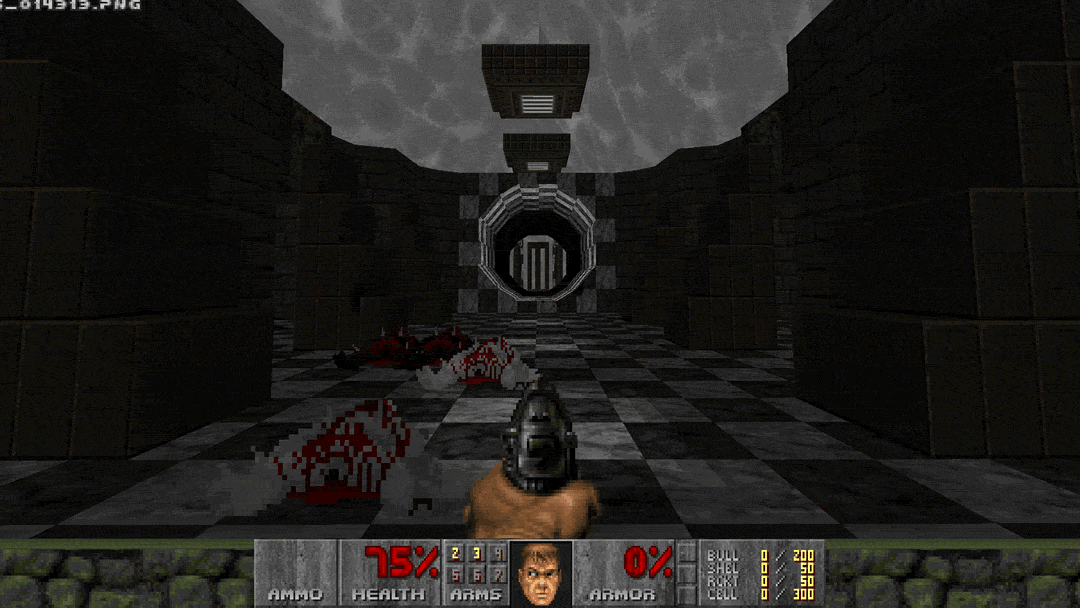
The reason I bring up Void is because it introduced to myself (and a lot of other people, I think) the potential of this new era of intensely creativity-driven Doom WADs. Void was an artistically deep project which (while borrowing the core tenants of Doom's amazing gameplay) represented a very specific vision of its creator, a personality that contradicts and rejects ID Software's original games. Departing from the industrial, brown environments we were used to, Void is a psychedelic gothic world being torn apart at the seams. Instead of giving us corridors of monsters to shotgun to death, it introduced a cocktail of unique challenges like platforming and puzzle-solving. The background music was a downtempo, melancholic and beautiful MIDI composition called "Exquisite" by Andreas Viklund.
You might find it weird to read words like "beautiful" and "melancholic" used to describe an experience that mainly involves shotgunning demons in the face. But, that's exactly how I'd describe Void. It commandeers the vehicle that ID Software built, and happily takes it in directions it was never intended to go. Does it feel discordant? No, not really.
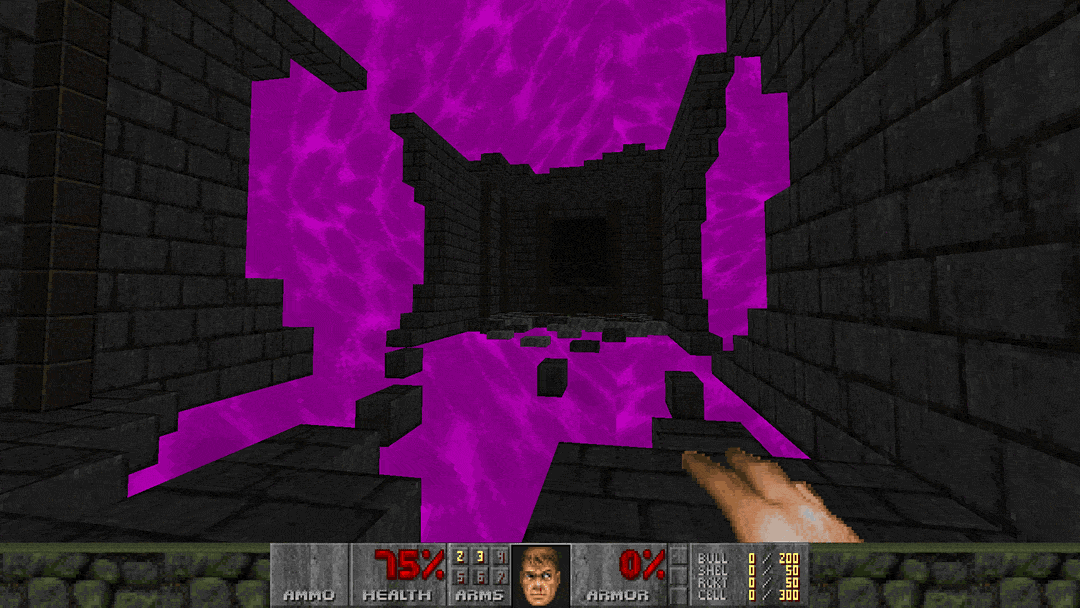
First, it's important to realize that the bloody violence I'm referring to isn't particularly visceral. What you're shooting at are 2d sprites made from photos of molded clay models, rendered using technology of over two decades ago. It might have been shocking and gruesome back in the day, but in a modern context, the violence feels highly abstract. This makes Doom a more versatile artistic platform than you might expect.
You might be familiar with the concept of “ludonarrative dissonance”: a concept describing a theoretical conflict between a video game's narrative told through its story, versus the narrative told through its gameplay. Doom WADs are a demonstration of why such dissonance is not intrinsically an issue.
If you can bare with the analogy, consider a musical: we go to a venue, witness the performers sing about dramatic affairs, and accept it as a means for us to receive a story and an experience. We don't ask, “Why is this character singing during this dramatic time in their life? Singing is not a realistic response.” No, we accept that the delivery mechanisms of the artistic experience are ludonarratively dissonant. It's merely a system which facilitates the communication of an experience in a specific way.
Similarly, Doom WADs tell their stories and present their tonally diverse experiences with confidence, acknowledging no dissonance, and the player accepts it just as unquestioningly. Playing Doom WADs, we might be told a story and given an experience which does not, at face value, correspond with what we are actually doing: shooting demons and splattering their blood against the walls. But it just works.
Of course, not every Doom WAD sets out to create such unique artistic experiences, in fact most probably do not, but I think the ones that do are something special indeed. It's the confidence and success with which these WADs can utilize its ludonarratively dissonant medium of demonslaying to create unexpected and creative experiences that I find beautiful and somewhat unique in video games. Despite using the same stage, actors, and rules as classic Doom, it can speak in its own voice and deliver its own performance. In a Doom WAD, you can experience a tale of awe and beauty, and do so by unloading a storm of bullets into a Hellknight's face. Perhaps not as polite as singing, but equally valid as an artistic delivery mechanism.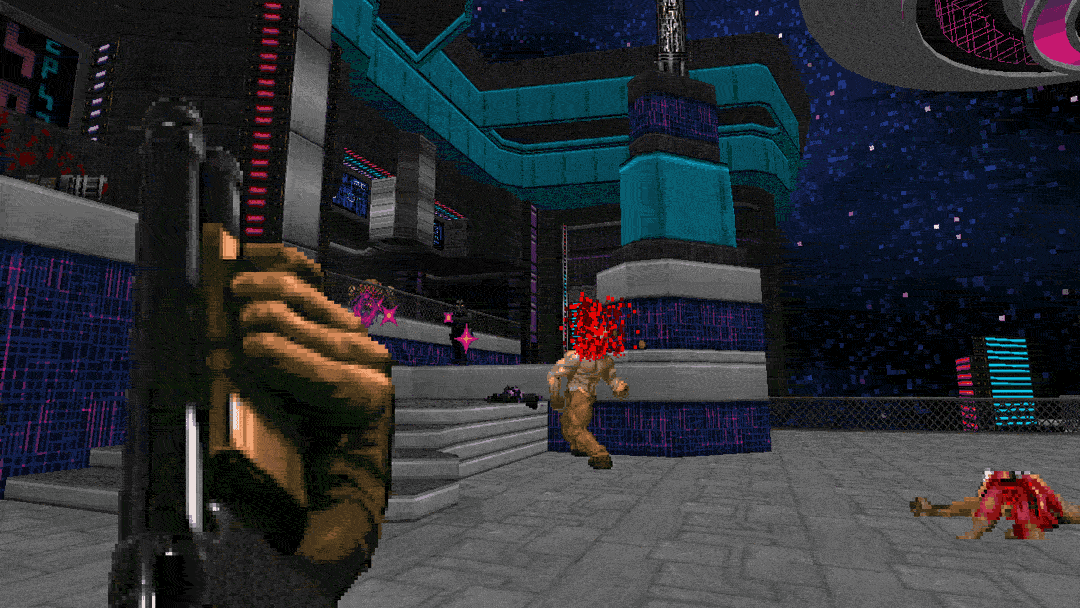
To recap: the gameplay is timeless, the community's artistic achivements are terrific. What's not to love? Now that I've hopefully piqued your curiosity, allow me to share with you some of my favourite WADs.
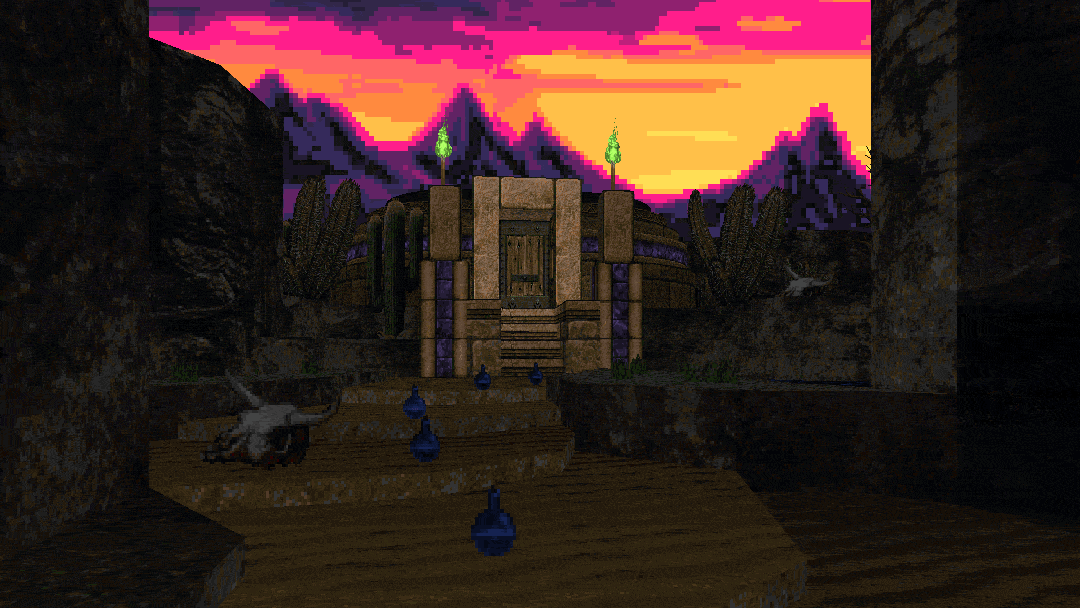
Everything I talked about previously regarding the dissonance between the core gameplay of Doom and a WAD creator's divergent vision can't be seen anywhere more clearly than in the beautiful and charismatic world of Ancient Aliens. It's probably my favourite WAD, even though the gameplay is a bit spottier than I'd like (gets a bit “slaughtery”. Doom people will know what I mean.)
One of the finest moments of its creator (Paul “skillsaw” DeBruyne) Ancient Aliens reintroduces the demons of Doom as part of an ancient alien conspiracy, like you might encounter on a History Channel documentary. It starts with Doomguy, alone in the desert, taking a peyote trip through a portal of spirit wolves and proceeding to use his newly-found magical peyote powers to slaughter an army of alien invaders.
The atmosphere is unbelievable. Its use of colours is unexpected, its architecture strange and beautiful, its themes playful and confident. You'd almost forget you were still playing Doom, if it wasn't for the comforting familiarly of the super shotgun, the BFG 9000, and your suspiciously-demonic alien opponents.
And oh my god, the music. The entire soundtrack was done by the legendary MIDI composer Stuart "Stewboy" Rynn. I will say nothing else about it and strongly urge you to listen to one of its first tracks, "The Incessant Flow of Time".
I'm not saying it was aliens, but... the truth is out there.
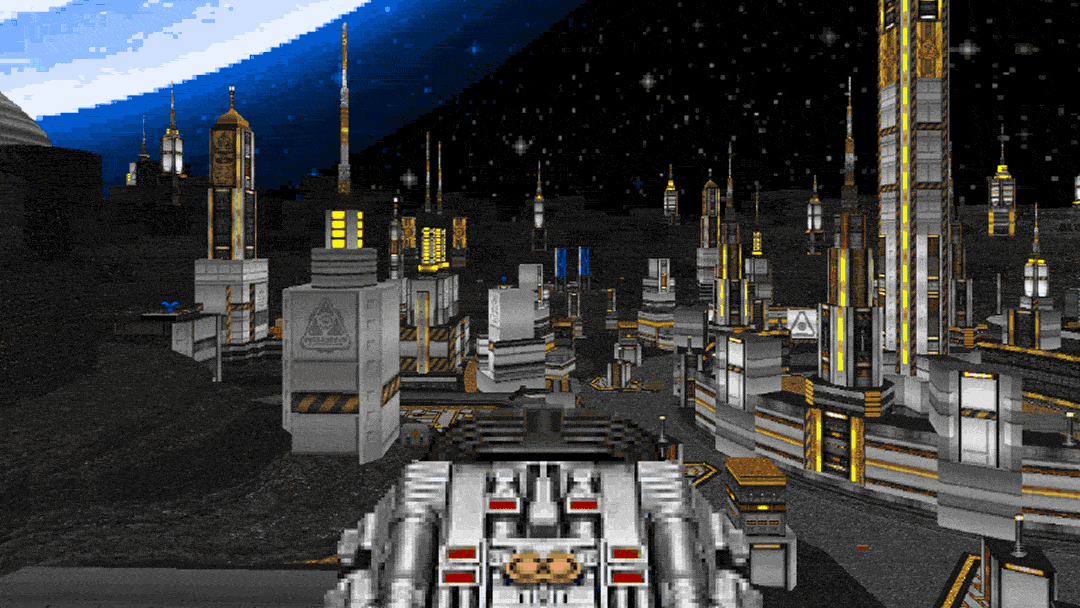
If there's one mod to play to get a taste for first-rate Doom excellence, Antaresian Reliquary is it. The first thing to note about Antaresian Reliquary is that it uses its own weapons pack, modifying all the existing weapons in the game. This is not a gimmick – I genuinely prefer the weapons used here over the original Doom. All the weapons are designed with a fine attention to game design and balancing, and it fixes all the issues I have with the original Doom arsenal. They're fun, explosive, familiar enough to be accessible, and somehow perfectly balanced in the context of the rest of the WAD.
The level design can't be praised enough. Every level is completely visually distinct, and carries a personality that no one could ever describe as “boring”. The gameplay design is, as far as I'm concerned, the very best of the bunch. The levels feel huge, but always reachable, and the placements of enemies and objects are crafted with laser-like precision to always keep the pace on target. The WAD revels in carnage, but knows when to pull the punches.
There's a wonderful creativity running through every aspect of the WAD, and I feel like talking about it too specifically would be spoiling it. It's not a very long WAD (6 levels and a few bonuses), and every moment is bliss. If you only try one WAD on this list, it should be this one.
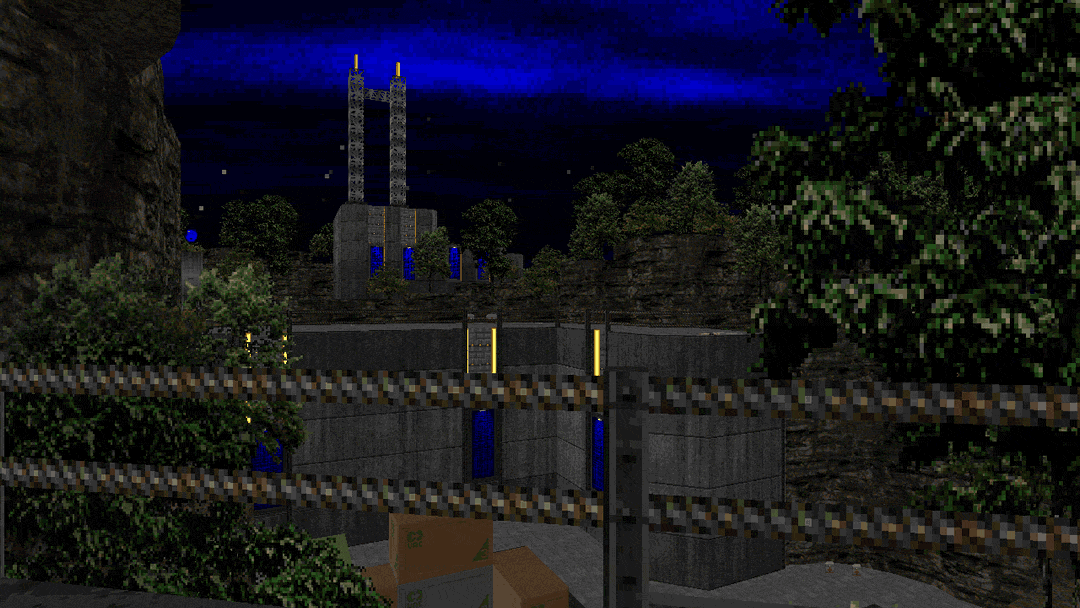
This is another project by “skillsaw”, the legendary figure who brought us Ancient Aliens among other highly-respected WADs. I've not finished this WAD –I'm actually playing through it as the time of writing – but I've immediately fallen in love with it.
Visually, it's definitely not what we're used to coming from classic Doom, but neither is it particularly exceptional, in my opinion. (At least so far.) The early parts of the WAD revolves around genetic experiments, cybernetic creatures and near-future cities. It's perfectly effective and I enjoy it, but it's not what I love about Valiant.
Valiant constantly surprises the player with interesting and unexpected situations and mechanics. Entire levels are often based on particular gameplay ideas, but so far I've not encountered one I would call ineffective or gimmicky. To give you some idea, my favourite level so far is called “The Mancubian Candidate”, the finale of the first chapter. It involves being forced to protect a hostile Mancubus from in-fighting with the other demons, following him on a platform up through a facility. It completely switches up the way you're used to playing Doom, and that is exactly what makes Valiant special.
Hopefully you've learned something from all these Doom-rambles, or at least gained some appreciation for the hard work people put into these things. Maybe you'll want to give one of these WADs a try. It's easy to get started: my recommendation is to download GZDoom and use it to run Antaresian Reliquary. Just follow these straightforward steps:
1. Go to the GZDoom website and download the latest version
2. Extract it
3. Place an original DoomII.WAD file in the GZDoom folder
4. Download Antaresian Reliquary
5. Drag ANTA_REQ.WAD to gzdoom.exe.
6. Select Doom II as the IWAD
7. Enjoy.
I suggest "Hey, not too rough" for a good starting difficulty, unless you want to dive into the carnage headfirst, in which case I recommend "Hurt me plenty". If you can survive on the latter, you're doing great. Good luck.




